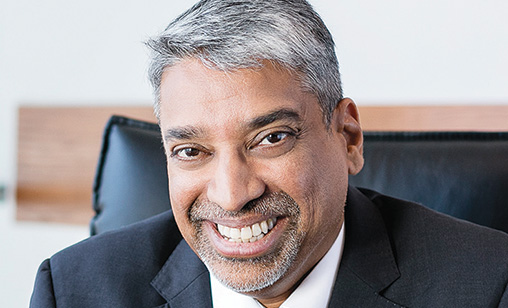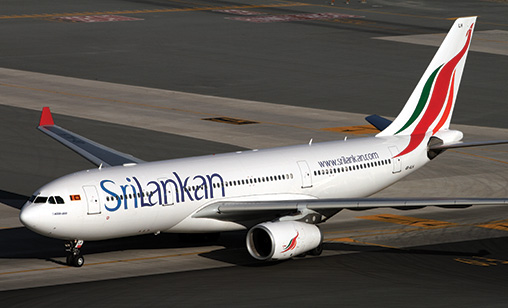News Backgrounder
Going nowhere on the capacity treadmill
Srilankan Airlines CEO, Suren Ratwatte, has taken on the job of rebuilding SriLankan Airlines, but his efforts could be in vain as Gulf carriers saturate his home market with capacity and cheap fares he can never match.
September 1st 2017
SriLankan Airlines CEO, Captain Suren Ratwatte says there is only one word to describe the Gulf carriers’ collective capacity attack on his home market - “ridiculous”. Read More »
Since Sri Lanka’s 25-year civil war ended in 2009, Ratwatte told Orient Aviation at a Sydney CAPA conference, the number of seats into the country’s international airport had jumped by 86% as the economy recovered from the domestic conflict and tourists to the island country increased.
 |
| 'If I had no financial constraints I would be happy to take five narrow bodies annually for the next couple of years because the Indian market is huge and I need to cash in on it before anybody else does' |
| Captain Suren Ratwatte Srilankan Airlines CEO |
“That is good,” he said. “It means more people flying in. But who added that capacity? It’s pretty obvious. It’s the Gulf carriers. If you take the increase in seats by the Gulf carriers alone it’s 155%. This is twice the additional capacity of all other carriers flying into the country, including Sri Lanka’s national carrier.
“Today, Emirates Airline and Etihad Airways serve Colombo with 73 flights a week. SriLankan operates 14 flights on the same routes. Qatar Airways flies 21 times weekly to my country. My airline operates seven flights between Doha and Colombo.
“They have six times as much capacity as we do in the same market. You can see where this is going. Where do all these passengers go? Only 32% of passengers on flights to the UAE actually disembark in the UAE. The remaining 68% go everywhere else. Given the fare structure of airlines today you know he who has the deeper pockets is going to win.
“Here is an interesting statistic. Approximately 44% of passengers on Sydney -Singapore flights are going to Singapore, whereas only 4% of passengers on Sydney-Doha flights are going to Doha. The remaining 96% are going elsewhere.”
Essentially, Middle Eastern airlines and some other carriers are draining the traffic from the notionally representative carriers onto their airlines, said Ratwatte. “The whole idea of a bilateral agreement is a joke. It does not apply anymore. These guys come in with deep pockets – and great service I must add – and they dilute yields to the point where the business becomes non-viable,” he said.
“The Europe to Sri Lanka average fare more than halved between 2013 and 2016, which is not a sustainable yield. You cannot continue to operate as a normal airline unless someone else is making up the difference.”
What happens in the end? “In 2012, we went to a whole bunch of countries: Heathrow, two destinations in Italy, Paris, Frankfurt, Zurich and Moscow. The numbers were reasonably healthy. Today, my European route network is one destination - London. I could not operate [anywhere else] without bleeding to death,” he said.
Ratwatte is a pilot of 30 years experience with more than 18,000 flight hours on aircraft including the B777 and the A380. He took charge at SriLankan in late 2015 and has the mammoth task of turning around the flag carrier.
 |
The news is not all bad he told Orient Aviation. He foresaw profits for Srilankan in the fiscal year to March 2018 despite the carrier’s net loss of $15.1 million in the 12 months to March this year.
“We have beaten our revenue forecast for each month of the current financial year. Our big problem is our cost base. If we can reduce that we will be profitable by the end of the financial year,” he said.
An added challenge for the SriLankan CEO is the government’s intention to privatize the carrier. Emirates, which sold a 43.6% holding in the airline in 2008, has denied it is an interested buyer second time around.
“Emirates have other challenges at the moment,” said Ratwatte. “There are other carriers interested, but probably an outside investment group is a more likely buyer. To be honest, I don’t have a lot of say, but I try to guide the government in the right direction on the issue.
“I would like to see us as a 100% private airline. I do not think governments should run airlines in this day and age. It does not make any sense at all. But it is a big mental shift on the part of the government to disinvest completely so let’s see how it goes. But certainly, we need the capital and it doesn’t make sense for a country like Sri Lanka to invest state capital in an airline.”
Ratwatte is waiting for the Sri Lankan government to approve his restructuring plan. The primary barrier to the carrier’s growth is available capital and he believed the government had to “act quickly” to advance restructuring process.
“We have had the inability to cash in on our captive market in South Asia. If we don’t act quickly, we will be left behind as ever increasing capacity from the Gulf and India is added to the market. We will lose market share,” he said.
Ratwatte’s strategy has “a little bit of downsizing” of staff and includes a network rationalization and a debt resolution plan. “Debt is our biggest problem. It’s all government debt so the government has undertaken to sort it out. There will be tinkering around the edges and I will have a much better bottom line,” he said.
The airline flies to 40 international destinations, but the network substantially favours the subcontinent. “We are the dominant carrier into India. We have more destinations in India than any other foreign airline. We intend to build on that.”
| 'I would like to see us as a 100% private airline. I do not think governments should run airlines in this day and age. It does not make any sense at all. But it is a big mental shift on the part of the government to disinvest completely so let’s see how it goes. But certainly, we need the capital and it doesn’t make sense for a country like Sri Lanka to invest state capital in an airline' |
It operates an all Airbus fleet of eight A320s, four A321s and 13 A330s, including two recently delivered A320neo and one A321neo. Three more A321neo are due to arrive by March next year.
“If we a draw a 1,000 mile circle around Colombo, key destinations include Hyderabad and the Maldives. They are in our natural market with 300 million people. The South Asian market still offers plenty of room for growth,” he said.
The carrier recently announced it would start Sri Lanka-Melbourne in October. China is an obvious growth market. SriLankan flies daily to Guangzhou and five times a week each to Shanghai and Beijing. “I’d like to go daily [to Shanghai and Beijing], but there are no slots,” he said.
“We also fly to Kunming. We are struggling a little with it so we are looking at that one very closely. It’s almost all leisure traffic and therefore very seasonal.”
Ratwatte holds both Bachelor and post graduate degrees from Embry Riddle Aeronautical University and is a Fellow of the Royal Aeronautical Society. He is well known in the field of aviation human factors and has published several research papers on the subject. Before he took on SriLankan he was Human Factors Manager at Emirates.
But his past employment at the Gulf carrier does not stop him bemoaning the “vicious cycle” his former employee and other Gulf carriers have sparked in his market.
“It never ends and airlines like mine, with limited access to capital and limited financial support from government, are going to find that it is almost impossible to compete,” he said.
“Historically we have been a capacity-driven business model. If others add capacity and you don’t, you are left behind so you add capacity. Then your seat factors drop and you add more capacity. You are running around just to fill these flights. Irrespective of how good your service is, it does not matter. It’s a purely price driven market. As you keep adding capacity you keep driving down the price. I don’t know where it ends.”